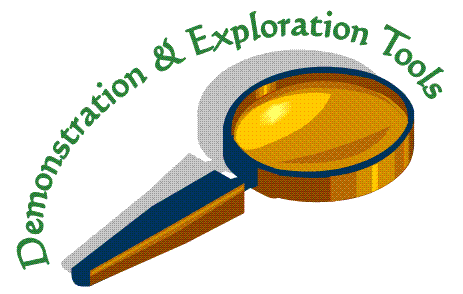Page Contents:
|
 |
| Broad Expectation* | Topic | Link to Applet and Description |
How good for teacher demos (1-3)? |
How easy for students (1-3)? |
How good for exploration (1-3)? |
Available activities |
| Understand numbers, ways of representing numbers, relationships among numbers, and number systems | Exponents | Powers of Ten - View the Milky Way at 10 million light years from the Earth. | 3 |
3 |
3 |
|
| Understand meanings of operations and how they relate to one another | GCD & LCM | Some Integer Functions Involving Division - from the Wolfram Demonstrations Project. You do need to download the Player. (Powered by Mathematica.) | 2 |
2 |
3 |
|
| Compute fluently and make reasonable estimate | ||||||
| Broad Expectation* | Topic |
Link to Applet and Description |
How good for teacher demos (1-3)?
|
How easy for students (1-3)?
|
How good for exploration (1-3)?
|
Available activities |
| Understand patterns, relations, and functions | Slope | Slope Comparison - Manipulate two segments. Slopes shown in decimal and fraction form. Can study parallel and perpendicular lines. |
2 |
3 |
3 |
Quickie |
| Slope of a Line - Drag points A and B and see the slope change. See rise over run. | 3 |
3 |
2 |
|||
| Functions |
Function pages from NLVM - Each of the following six pages has interactive investigations on functions. Quite comprehensive. Each link has multiple pages. |
2 |
3 |
3 |
||
| Function (general) | Function Flyer - one of the best applets on the web. Allows user to input function, manipulate x, and manipulate coefficients. |
3 |
3 |
3 |
||
| Slope-intercept Form of a Line - Drag m and b. | 3 |
3 |
2 |
|||
| Regression Equations | Linear Model - Real basic. Good starter applet for regression. |
3 |
3 |
3 |
#28 in the Recording Sheets | |
| Represent and analyze mathematical situations and structures using algebraic symbols | Expressions | Pan Balance-Expressions - Interactive pan balance allows numeric or algebraic expressions to be entered and compared. This balance is a natural extension of Pan Balance-Numbers and Pan Balance-Shapes. |
3 |
3 |
3 |
Included online |
| Distributive Property, Multiplying Binomials, and Factoring | Algebra Tiles - Visualize multiplying and factoring algebraic expressions using tiles. |
3 |
2 |
3 |
||
| Solving Equations | Algebra Balance Scales - Positive quantities represented by blocks, negative by balloons which lift. Uses and balance and the equation is solved algebraically. |
3 |
3 |
3 |
||
| Use mathematical models to represent and understand quantitative relationships | ||||||
| Analyze change in various contexts | ||||||
| Broad Expectation* | Topic |
Link to Applet and Description
|
How good for teacher demos (1-3)?
|
How easy for students (1-3)?
|
How good for exploration (1-3)?
|
Available activities
|
| Analyze characteristics and properties of two- and three-dimensional geometric shapes and develop mathematical arguments about geometric relationships | ||||||
| Specify locations and describe spatial relationships using coordinate geometry and other representational systems | ||||||
| Apply transformations and use symmetry to analyze mathematical situations | ||||||
| Use visualization, spatial reasoning, and geometric modeling to solve problems | ||||||
| Broad Expectation* | Topic |
Link to Applet and Description
|
How good for teacher demos (1-3)?
|
How easy for students (1-3)?
|
How good for exploration (1-3)?
|
Available activities
|
| Understand measurable attributes of objects and the units, systems, and processes of measurement | Rates | Understanding Distance, Speed, and Time Relationships - Simulation of two runners along a track. Explore slope and starting points. |
3
|
2
|
3
|
|
| Learning about Rate of Change - cost per minute of phone use. Linear Functions Using Interactive Graphs. See also Changing Cost per Minute. |
3
|
2
|
3
|
|||
| Apply appropriate techniques, tools, and formulas to determine measurements | Convert Units | Converting Units - Interactive. "Multiply by a form of 1" to convert. |
3
|
3
|
3
|
built in
|
| Broad Expectation* | Topic |
Link to Applet and Description
|
How good for teacher demos (1-3)?
|
How easy for students (1-3)?
|
How good for exploration (1-3)?
|
Available activities
|
| Formulate questions that can be addressed with data and collect, organize, and display relevant data to answer them | Graphing Data | Create a Graph Tool - for students (others) to make statistical graphs (NCES). |
3
|
2
|
3
|
|
| Select and use appropriate statistical methods to analyze data | ||||||
| Develop and evaluate inferences and predictions that are based on data | ||||||
| Understand and apply basic concepts of probability | ||||||
Click here for the Index for >> Online Math Games, Demonstration/Exploration Tools, and Puzzles
(This page is organized using the five content areas in school mathematics, as articulated in the NCTM Principles and Standards, 2000.)
3=Excellent for class demonstrations of mathematics
2=Fair to Good for class demonstrations of mathematics
1=Not designed for class demonstrations of mathematics
3 = No advance instruction needed (very easy to use).
2 = Short demonstration helpful (pretty easy to use).
1 = Extensive demonstration needed (hard to use without an explanation).
3=Excellent for student exploration of mathematics.
2=Fair to Good for student exploration of mathematics.
1=Not designed for student exploration of mathematics.
by: James
R. Olsen, Western Illinois University
updated:
December 14, 2011